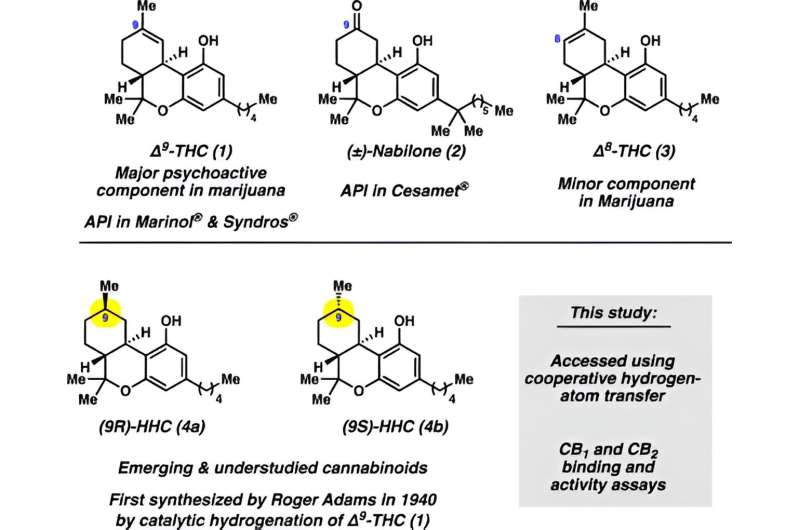This article has been reviewed according to Science X's editorial process and policies. Editors have highlighted the following attributes while ensuring the content's credibility:
fact-checked
peer-reviewed publication
trusted source
proofread
Consumers who buy cannabis products containing HHCs could be getting less than they hoped for

As more of the nation has adopted legal marijuana, a glut of products containing the psychoactive ingredient in marijuana, THC, as well as other cannabinoids that can be derived from THC or the plant itself, has emerged in dispensaries.
Cannabinoids is the umbrella term for a group of substances that bind with cannabinoid receptors in the body and brain. Some cannabinoids, of course, are found in the cannabis plant, the best known of which is THC. But many of the new products being sold in dispensaries today are made with other classes of cannabinoids whose neurological or physiological effects are not well understood.
That has created a kind of "wild west" in the marijuana marketplace, making it difficult for governments to regulate the new products and develop fair laws regarding their use.
UCLA chemist Neil Garg is one of a group of scientists who are rapidly learning more about emerging cannabinoids. Their goals include ensuring the safety of products being sold to consumers and helping government agencies develop evidence-based laws for the fast-growing industry.
A new paper by Garg and colleagues takes a close look at one class of those emerging cannabinoids: hexahydrocannabinols, or HHCs. The study systematically evaluates how well HHCs bind to receptors in the human body. The work is published in ACS Chemical Biology.
"The compounds have been tested in animals before, but the basic binding assays of each isomer were somehow not done or not reported," said Garg, UCLA's Kenneth N. Trueblood Professor of Chemistry and Biochemistry, a UCLA distinguished professor and the paper's senior author. "That is unusual for a product that's widely available to consumers, and it reflects the need for more fundamental research in this rapidly evolving field."
HHC products on the market today typically contain a mixture of two different versions, or isomers, of the HHC molecule. In the new study, the scientists found that although both isomers bind to the same cannabinoid receptors in the body as THC does, only one of the isomers binds as well as THC does—which suggests that it is the only HHC isomer with effects comparable to THC.
The paper also describes a new method for synthesizing the more biologically active of the two HHC isomers.
Most HHCs found in commercially available products are synthesized from THC by manufacturers using a process called catalytic hydrogenation. The technique produces both isomers of HHC in variable ratios. As a result, there is little consistency in the amount of each HHC isomer in HHC products—not only from one brand to the next but even among batches produced by the same manufacturer. And because the ratios are variable, some HHC products being sold to consumers contain relatively little of the more biologically active isomer.
Garg and Daniel Nasrallah, a UCLA assistant adjunct professor of chemistry, developed a method that relies instead on a chemical process called hydrogen atom transfer. Using their method to produce HHCs yields roughly 10 times more of the biologically active isomer than the less active one.
The new method also is safer than catalytic hydrogenation, a process that uses hydrogen gas, which when not handled carefully can lead to laboratory fires. Labs that use catalytic hydrogenation also often use potentially toxic heavy metals like platinum or palladium as part of the process.
"If a medical drug was being synthesized using these metals, careful analysis would be required to ensure these metals are not present in the final commercial products in order to avoid any toxicity concerns," Garg said.
Nasrallah said that generally is not happening now. "Typically, HHCs being sold for recreational use are not analyzed for the presence of platinum or palladium," he said.
Garg said further research on cannabinoids and their effects is essential.
"These studies are crucial if we are to have laws and policies that are fair and allow for consumer safety, while allowing scientists and society alike to explore the potential therapeutical effects of new cannabinoids," he said.
The paper notes that although there is a popular belief that HHCs are legal under federal law, the U.S. Drug Enforcement Agency considers them illegal.
More information: Daniel J. Nasrallah et al, Studies Pertaining to the Emerging Cannabinoid Hexahydrocannabinol (HHC), ACS Chemical Biology (2023). DOI: 10.1021/acschembio.3c00254
Journal information: ACS Chemical Biology
Provided by University of California, Los Angeles




















